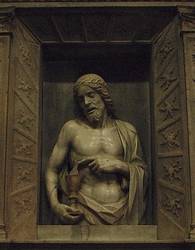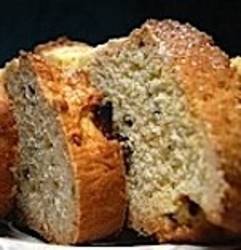“Lucca is one of the most beautiful small towns in Italy.” So begins the description of the town in Blue Guide Tuscany. And it is true. Lucca, in my opinion, is as good as Tuscany gets. It was a Roman town, and the shape of its amphitheatre is atmospherically preserved in an elliptical piazza, ringed around by medieval houses. Its church façades are spectacular, richly carved in a characteristic mix of pink, green and white marble. Rusking sketched them obsessively.
Lucca is close to the great quarries of Carrara and Pietrasanta, where Michelangelo came in search of perfect, unveined blocks, and it has a tradition of excellence in carving. Its most important native artist is Matteo Civitali (1436–1501), whose expressive works are to be seen almost exclusively in and around Lucca.
Lucca is also a town of cyclists. Its old medieval fortifications are splendidly preserved, and around the top of the walls there is now a bicycle track, which goes all around the town offering magnificent views. It is also well worth hiring a bike and striking off into the surrounding countryside, lovely farmland criss-crossed by small streams, the houses all with characteristic haylofts with walls of louvred brick for ventilation.
Unlike many towns in Tuscany, Lucca was never subject to Florence and the Medici. From the late 14th century until the days of Napoleon, who arrived in 1799 as part of his Reorganise Europe road trip, Lucca maintained a proud tradition of independence. It is perhaps this that gives the town so much of its special character. It also has important musical associations. It was the birthplace of Puccini, and from 1805 to 1808 Paganini was here, working as court violinist to Napoleon’s sister Elisa, to whom the ambitious Corsican had arbitrarily presented Lucca as a principality. Her country home, the Villa Reale, lies in the foothills northeast of the town, at Marlia, and is open to the public (www.parcovillareale.it). Close by, at Lammari, in the church of San Jacopo, is the last work of Matteo Civitali (illustrated below). It is a tabernacle of the Redeemer, shown emptying his own blood into the Eucharistic chalice, a symbol of his sacrifice to redeem mankind.
Typical dishes of Lucca’s cuisine include tordelli lucchesi, pasta pockets filled with spiced meat and served in a meat and tomato sauce. Buccellato is a delicious, simple cake flavoured with aniseed and raisins (photo © www.tarantini.srl.com). As the old saying goes, ‘If you don’t eat buccellato, you haven’t been to Lucca.”








